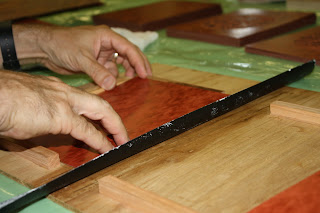.JPG)
[Tom Gammarino, Todd Shimoda, Linda Shimoda; photo by Steve Canham]
What better way not to watch a game of the World Series sans Cardinals than to attend a reading by writers (and an artist) of Chin Music Press? And so on Thursday, I went to hear Todd and Linda Shimoda talk about their literary/artistic collaboration, OH! a mystery of mono no aware, and M. Thomas Gammarino (we call him Tom because he's a Ph.D. grad student here) reading from his first novel Big in Japan: A Ghost Story. The works were high and tight, as befits the press that published them.
Both books are as involved with ideas as with plot-lines; their subtitles tell us that. Todd Shimoda's book is the third of a "loose" trilogy: the first features woodblocks and robotics, the second calligraphy and neuroscience, and this third, poetry and social networking. OH! offers up Zack Hara, "emotional eunuch" tech writer in L.A. who goes to Japan, teaches English, gets caught up in an on-line suicide pact, and becomes a vehicle for notions of mono no aware, or "things of sadness." Thus, the mystery of the book (as I gather, having heard only bits of it at the reading) is as much what mono no aware is as how Zack resolves, or fails to resolve, his emotional vacuum. Linda Shimoda talked about the way in which she and her husband collaborate on projects. She is a visual artist, very much involved in Japanese calligraphy and art. The process sounded somewhat familiar to me from Tinfish, where our collaborations are less than concurrent conversations, more like parallel tracks on a related route. Todd and Linda talk about a shared concern, and then adjourn to separate work spaces for months. He writes a novel, she creates a series of images. When they've finished their solo projects, they come together and organize the two pieces in conversation. Thus, Linda's project on emotions entered into his project on the failure of emotion; then, a third eye entered in the person of the graphic designer for Chin Music. The result is a stunning artist's book (how can it be sold for $22.50?).
In his recent Ph.D. prospectus defense, Tom Gammarino had waved OH! around as an exemplar of what he believes will happen once trade paperbacks migrate into Kindle form. The book, as object, will then be freed up to be an art object, rather than a mere carrier of words. We shall see, but the premise sounds reasonable.
Tom began the reading with a story. When he first went to Japan, he had long hair. The summer was too hot. He went to get it cut. He only knew three phrases in Japanese, two of which were "hello" and "good-bye." He and the hair-cutter communicated through gestures and pre-linguistic noises, which he replicated for us. She cut a large swath of his hair, sounded a question, whereupon he uttered his only other phrase of Japanese, "mono no aware!"
Tom's protagonist is a white American who goes to Japan with his band, Agenbite (yes, Joyce fans, that one); Agenbite is to Tom's book what mono no aware is to Todd's. Like Zack Hara, his emotional life is not right. Brain (his name invokes Pynchon, as does a lot of the book, which hearkens back to V. to this reader) falls in love with a Japanese sex worker, cannot separate love and sex, gets involved with a student, breaks up with her (much to her failure to care), and so on. As you can tell already, Tom is ushering in every stereotype adhered to by stereotypical American white males in Asia, but he attempts at the same time to expose and demolish them. This is a dangerous course, to put it mildly. But he mostly does so. The book is flat-out funny; he plays with the stereotypes the way a cat does with its prey, like some latter-day Rabelais.
What I most appreciated about Tom's writing, aside from its go-for-broke humor, was the way in which he crafts sentences. The book is not written in the clumsy everything-for-the-plot manner of much fiction, but almost as a collection of tightly wrought sentences. Tom's attention to language finds its tightest focus, however, toward the end of the book, when Brain is high on mushrooms (he ate them in a sandwich) begins to think in Japanglish.
You speak Japanglish now. Japanglish speaking is by what you are. At least the dad was honest. Strict vew of life, was his truth, you were informed entirely, it was war. You take those, the wife while having sexual intercourse, the specialist and of substance you are polite mutually. That then a certain way.
__________
Who gets to speak, and for whom, is a huge issue in Hawai`i. Tom's book takes it on like Philippe Petit on his rope. The question loomed when I attended Craig Howes's English 620 (Introduction to the Profession of English) course this past week. I was there to introduce "issues in creative writing" to the entering M.A. students. I did so by asking them to read one issue of one of the journals published in Hawai`i now: Bamboo Ridge, Manoa, `oiwi, Tinfish. Given that all of these journals are published in Hawai`i, their sense of where they are and whom they speak for is crucial not just to the editors of these journals, but also to their readers. While all of these journals are now active, one gets the sense of a current narrative that posits Bamboo Ridge as an historical object, `oiwi as a current one, and Manoa and Tinfish as tangential to current stories told about Hawai`i's literature. While there's an inevitability to this narrative, I find it unfortunate, based more on ideas about Hawai`i than about what one actually finds in the journals. Local literature, as it is taught in my department now, is seen almost exclusively through the lens of Asian Settler Colonialism, which posits Asians as part of a problem (colonialism, cultural appropriation, and so on), not part of possible solutions. Such readings, while they aim to be ethical, often rely on binary moral paradigms to make a space for Hawaiian literature and culture by sweeping away the claims (or indeed the texts) made by Asian local writers. Sure, the stories about grandpa fishing and grandson later on eating the food placed on his grave, have lost their eclat (they probably lost that eclat in the 1980s), but Bamboo Ridge has published Lee Tonouchi and Hawaiian playwrights in recent years. That they published a book by Ian MacMillan was itself a fascinating, but not often commented upon, event. He was the first white writer to be included in their canon of single author texts.
I asked Craig's students to imagine journals that would fill literary holes. They tended toward strategies of representation (generation, gender) and genre (nonfiction came up more than once). Publishing, I suggested, should not be considered from the point of view of desire to be published, but from the need to create communities of writers by way of becoming publishers. I look forward to reading examples of the work that feels necessary to these students.
I talked a bit about how a book like Tinfish 18.5 , whose writers are all Hawai`i born and raised, tries to field a conversation between writers from Hawai`i that is not based on nationality or race. I don't mean this to be a collection of "local writers," either. The term "local" seems to have outworn its usefulness. Perhaps we can develop new terms for the literature that creates alliances between writers in Hawai`i, no matter their identity positions or even aesthetics (though Tinfish's aesthetics are pretty clear at this point). I hope Tinfish can provide one model for possible literary futures here.
















